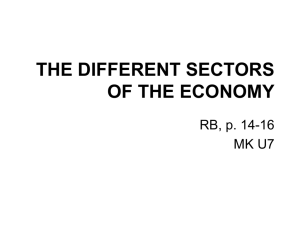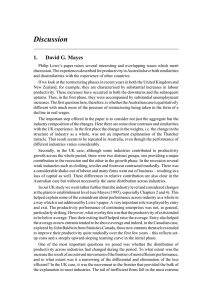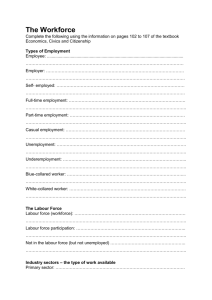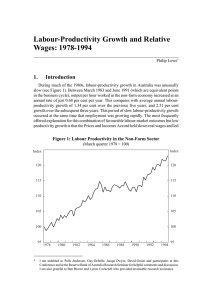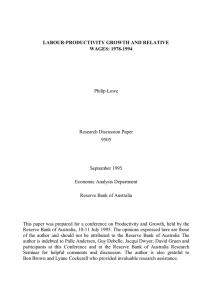MET - industriAll
advertisement
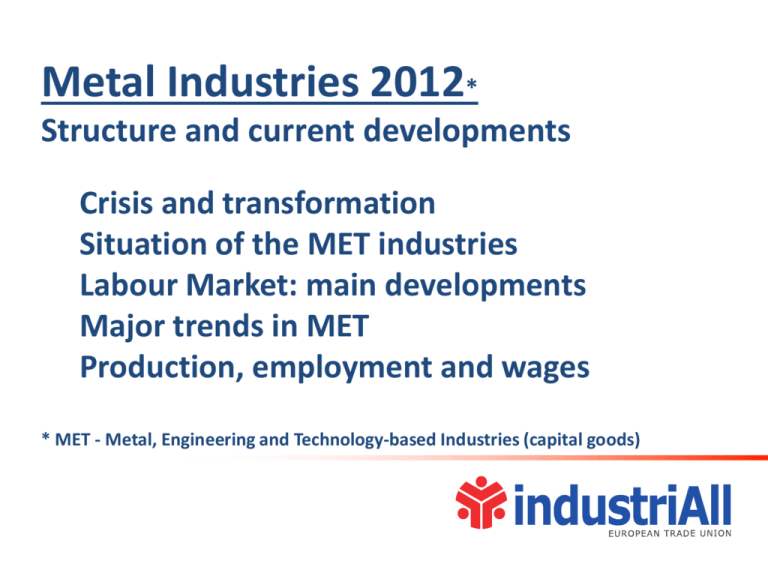
Metal Industries 2012* Structure and current developments Crisis and transformation Situation of the MET industries Labour Market: main developments Major trends in MET Production, employment and wages * MET - Metal, Engineering and Technology-based Industries (capital goods) Economic and social situation in Europe EU economy still under pressure: Debt crisis and austerity policy severely weaken consumer and industrial demand Unemployment at record level MET EU economy still under pressure: • But MET industries have the biggest growth potential of all industrial sectors in Europe • Most MET sectors grew faster than the average for industry or manufacturing as a whole • Pharmaceuticals, chemicals, rubber & plastics have similar potential MET: Future Key Sectors Better development than basic industries (intermediate goods) or durable consumer goods Structural change and negative austerity influences in Shipbuilding, Defence activities and Fabricated Metal Products Automotive Industry currently under pressure Future of SD MET: Preconditions for a successful SD MET Being always aware of the basic economic situation and development trends in our sectors What does this mean? • What about our economic position? • Where do we come from? • In what direction do we want to go? Based on the answers we will be able to discuss the political, economic and social needs. What about the economic situation of industry? Share of total employment is decreasing, from 17.7% in 2005 to 16% in 2011 … crisis, structural change, more industrial services What about the economic position of MET? MET sectors occupy a very strong position within industry. Despite losing 1.2 M jobs , the share of total employment increased from 47.8% in 2005 to 48.9 % in 2011. In comparison, much bigger decline in employment in basic industries, mining or textiles & clothing What about the economic position of MET? MET industries are working across national borders within regional added value chains We therefore need specific, adjusted solutions for the different regions What about the economic position of MET? Strong key sectors - Machinery and equipment - Motor vehicles - Aircraft industry - Electrical equipment - Medical equipment - Computers, electronics & opticals - Repair and installation services remain within the MET sectoral scope - But related industrial services are increasingly handled by the services sector What about the economic position of MET? Trends in the MET industries underline that development depends on regional added value related to technological capability and access to the main key markets However, it also depends on macroeconomic preconditions What about the economic position of MET? MET industries in most countries showed strong productivity gains since 2005, especially the transformation countries of Eastern and SouthEastern Europe , but in Central and Northern Europe as well Countries that are heavily hit by the debt crisis recorded lower productivity gains or a downward trend MET employment under pressure Despite the relatively positive development of production, employment decreased heavily in some industries but not as much as in the intermediate sectors Account has to be taken of the productivity effects and changes in employment structures (temporary agency work, subcontractors, etc.) Economic crisis weakens MET employment Most countries in Europe showed a fall in MET employment, especially countries in Southern Europe that are heavily hit by the debt crisis or countries that are dependent on the European market Higher MET employment was seen in countries that are more active world-wide or are in an intensive value chain with such industries. Development of wages In most European countries MET wages have grown faster than the inflation rate since 2005 Bigger increases were enjoyed by workers in East and South Eastern Europe transformation countries. However, in Greece, Norway, Portugal and UK wages grew more slowly than consumer prices MET Retail Prices In most European countries MET industries increased their retail prices over the last six years. Productivity and output prices have often increased much faster than wages. That is why many MET companies were able to show shrinking unit labour costs and rising profits. In one or two countries MET companies managed to improve their competitiveness by cutting prices to the detriment of workers’ wages. MET: Unit labour cost In a first group of European countries wages grew much slower than productivity. Companies improved their competitiveness to the detriment of workers’ wages. In a second group, increasing unit labour costs were covered by rising retail prices, especially in several Eastern and South Eastern European countries. In a third group, increasing unit labour costs were the result of the crisis: with production shrinking more than employment. Conclusions: MET Industries are in a very strong industrial position and should be supported by appropriate industrial policy measures. The revised industrial policy Flagship Initiative identifies several measures that should be supported. However, this strategy has to be supplemented by proposals from the social partners. Conclusions: Our industries must be supported via sustainable measures. We should permanently analyse and discuss changes and risks, influences on business development, structural risks and opportunities. Therefore we – industriAll Europe and CEEMET - should build up an early warning and risk management system. Conclusions: What should such a system cover? • Regular analysis of MET key economic figures • Discussion of appropriate labour market measures to avoid negative short-term business developments and precarious work in our sectors • Discussion of industrial policy measures to support structural change (anticipation of change, training and education) • Analysis and discussion of “Health & Safety” and “Occupational Pension Systems” ,etc. to provide adequate and sustainable working conditions .





